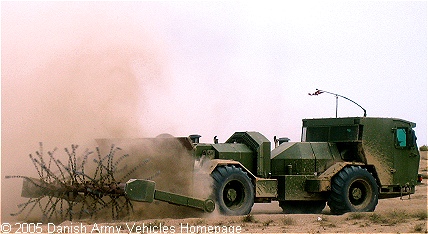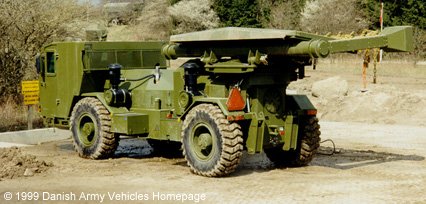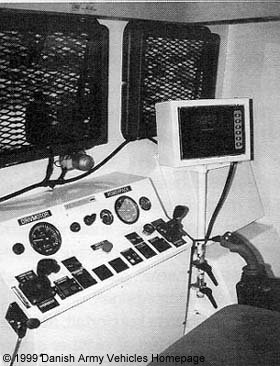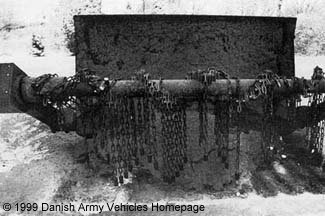Danish Army
Specific: The army awarded the
Danish company A/S Hydrema a contract late 1996 to supply
the vehicles after an international competition and
trials.
The first four Hydrema 910 Mine Clearing Vehicle (MCV)
systems was handed over in DEC 1997 to the Danish Army,
with the remaining eight to follow early 1998. Additional
2 was acquired late 2001/early 2002.
Historical: The Hydrema 910 MCV builds on the
company's experience in design, development and
production of off road vehicles, mainly for the
construction industry, as well as its experience in
hydraulics. To reduce life cycle costs, proven and
in-production components have been used where possible.
The MCV is designed for rapid clearance of surface or
buried anti-tank mines which contain up to 10kg of high
explosive in military and peacekeeping operations.
In 2003 24 units of the improved 910MCV2, including
training and spare parts, have been sold to the Indian
armed forces.
Length: 8.50 (331 inches).
Width: 2.80 (109 inches).
Height: 2.70 m (105 inches).
Weight: 18.000 kg (39.600 lb.).
Armour: 14 mm.
Engine: 2 Perkins 1006-6TW 6-cylinder turbocharged
diesel engines.
Horsepower: 178 hp ea. at 2.600 rpm.
Transmission: Six-speed ZF 6WG150 semi-automatic
transmission/separate hydrostatic transmission.
Transfer case: None.
Electrical system: 2 x 24V.
Brakes: Dual circuit servo assisted with oil
immersed discs on all wheels.
Tyres: 17.5 - 25 non-directional with
foam filling.
Fording depth:
without preparation: N/A.
with deep water fording kit: N/A.
Fuel type: Diesel.
Fuel capacity: 300 liter (66 gallons).
Range: N/A.
Crew: 2.
Armament: None
Additional: The vehicle is based on an
articulated chassis so that all four wheels are in
contact with the ground at all times. When being driven
on roads, the cab is to the front; during mine clearing
operations, the vehicle is driven in reverse with the cab
to the rear. The fully-enclosed, all-welded steel armour
cab protects the occupants from small arms fire up to
7.62 mm armour piercing calibre and large bullet-proof
windows give all round visibility. For increased crew
comfort during travelling and mine clearing operations,
the cab is suspended in rubber elements. It seats three
people although the system is normally operated by a crew
of two.
The vehicle is powered by two Perkins 1006-6TW 6-cylinder
turbocharged diesel engines. One is used for driving the
vehicle and is coupled to a six-speed semi-automatic
transmission. The second diesel engine powers the mine
clearing flails. Each engine has its own cooling, air
filter, exhaust and hydraulic system. During mine
clearing operations, a separate hydrostatic transmission
is used which gives a continuously variable speed and
considerable tractive force. This hydrostatic driving
unit can be supplied from the hydraulic system of the
powerpack and can be used in an emergency should the main
engine stop, enabling the Hydrema 910 to move out of
immediate danger under its own power.
The MCV can be driven on roads up to a maximum speed of
35km/h. The vehicle is steered through a hydrostatic
pivot steering system on all four wheels with an
emergency backup in case of engine failure. The fuel
tanks hold 300 liters and these are integrated onto the
chassis for maximum protection. When travelling, the
complete flail system and deflector, which is suspended
on hydraulic systems, is raised clear of the ground and
traversed through 90° using a hydraulically operated
tilting/turning system so that it is in line with the
chassis. In this configuration, it can be driven on
public roads.
When required, the complete flail system is rapidly
lowered into position at the rear. The system can clear a
mine path 3.5m wide. During mine clearing, the vehicle
can be operated using a joystick or through the use of a
computerised fully automatic pilot steering system. When
being used in the latter configuration, the operator
needs only to select a number of key parameters, for
example depth, on the monitor. The depth control of the
flail and the armoured deflector plate, which is
positioned to the immediate rear of the rotating flail,
is then fully automatic using sensors. The chains rotate
clockwise if mines are buried and anti clockwise if they
are on the surface. The mine clearing part consists of a
rotating axle to which are attached 72 chains; the end of
each of these is fitted with a hammer type head which
weighs 0.9kg. When these chains or heads are damaged,
they can be easily and quickly replaced The axle rotates
at up to 400rpm, with the speed depending on the nature
of the terrain. Mine clearing speeds depend on a number
of factors. On cross-country terrain, for example, it is
about 1.4 km/in while on a firm hard surface it could be
up to 12km/h.
Standard equipment for the Hydrema 910 MCV includes a 200
liter water tank and high pressure cleaning system;
options include a Global Positioning System (GPS). As the
system may be required for operations in any part of the
world, it is fully air portable in a Lockheed Martin
C-130 Hercules transport aircraft without further
preparation, and can be ready to use within 2 minutes.
Jane's Defense Weekly December 1997
|



